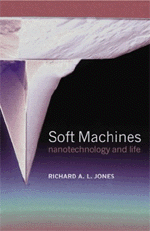A debate about nanotechnology last Monday at the Royal Institution was run in association with a project called Small Talk, which is planning to run dialogue events about nanotechnology across the UK. This project is a collaboration between the leading organisations in science communication in the UK, The Royal Institution, the British Association, a group of science centres and the Cheltenham Festival of Science. For a science communication organisation they are being a bit reticent, in that they haven’t yet got a web-site up, but I guess we can take this as evidence that nanotechnology has come to the top of the agenda of the science communication professionals.
To be honest, I thought that last Monday’s event actually highlighted some of the problems that this enterprise faces. There are a number of different levels at which one can talk about nanotechnology. You can have a straight discussion about what the technology actually is and what it is likely to become in the near future. At this level, there’s going to be some work to do explaining the basic science, as well as some mentions of the traditional exhibits of contemporary nano-business: tennis rackets, sun-cream, stain resistant trousers etc. You can discuss the debate about what the future holds for the technology, and what the prospects are for the Drexlerian visions. And you can also discuss how one ought to run debates about science and technology and what the right relationship between the public and scientists should be. It’s easy to end up trying to talk about all three, and the result of this is confusion and an unfocused discussion.
While I do applaud James Wilsdon’s notion of an upstream debate, in which people get to discuss technology before it actually arrives, it does take for granted that there are some common assumptions about what the technology actually is. We don’t yet have that common ground when we talk about nanotechnology.
